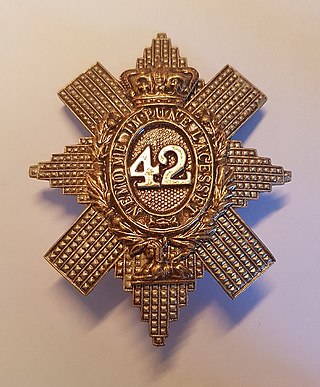Related Research Articles
The Atholl Highlanders is a Scottish private infantry regiment. A ceremonial unit, it acts as the personal bodyguard to the Duke of Atholl, chieftain of the Clan Murray, a family that has lived in Perthshire for roughly seven centuries. Although it has no official military role, this hand-picked body of local men are armed with Lee–Metford rifles, and the regiment includes a pipe band. Joining the Highlanders is by invitation-only from the Duke, who specially selects men with ties to the estate or the local area. The regiment is not part of the British Armed Forces but under the command of the Duke of Atholl, and based at Blair Castle, Blair Atholl.

William George Drummond Stewart, VC was a British Army officer and a recipient of the Victoria Cross, the highest award for gallantry in the face of the enemy that can be awarded to British and Commonwealth forces.

The Gordon Highlanders was a line infantry regiment of the British Army that existed for 113 years, from 1881 until 1994, when it was amalgamated with The Queen's Own Highlanders to form The Highlanders. Although the 'Gordon Highlanders' had existed as the 92nd Regiment of Foot since 1794, the actual 'Gordon Highlanders Regiment' was formed in 1881 by amalgamation of the 75th (Stirlingshire) Regiment of Foot and 92nd Regiment of Foot.

The Glasgow Highlanders was a former infantry regiment of the British Army, part of the Territorial Force, later renamed the Territorial Army. The regiment eventually became a Volunteer Battalion of the Highland Light Infantry in 1881. The regiment saw active service in both World War I and World War II. In 1959 the Highland Light Infantry was amalgamated with the Royal Scots Fusiliers to form the Royal Highland Fusiliers. The Glasgow Highlanders was later amalgamated into the 52nd Lowland Volunteers in 1967.

The 73rd Regiment of Foot was an infantry regiment of the British Army, raised in 1780. Under the Childers Reforms it amalgamated with the 42nd Regiment of Foot to form the Black Watch in 1881.

The 42nd Regiment of Foot was a Scottish infantry regiment in the British Army also known as the Black Watch. Originally titled Crawford's Highlanders or the Highland Regiment and numbered 43rd in the line, in 1748, on the disbanding of Oglethorpe's Regiment of Foot, they were renumbered 42nd, and in 1751 formally titled the 42nd (Highland) Regiment of Foot. The 42nd Regiment was one of the first three Highland Regiments to fight in North America. The unit was honoured with the name Royal Highland Regiment in 1758. Its informal name Black Watch became official in 1861. In 1881, the regiment was amalgamated with 73rd (Perthshire) Regiment of Foot under the Childers Reforms into The Royal Highland Regiment , being officially redesignated The Black Watch in 1931. In 2006, the Black Watch became part of the Royal Regiment of Scotland.

The 92nd Regiment of Foot was a British Army infantry regiment, raised in 1794. Under the Childers Reforms it amalgamated with the 75th (Stirlingshire) Regiment of Foot to form the Gordon Highlanders in 1881.
Two regiments of the British Army have been numbered the 116th Regiment of Foot:
The 100th Regiment of Foot, also known as Campbell's Highlanders, was an infantry regiment of the British Army, formed in 1760 and disbanded in 1763.
The 87th Regiment of Foot (Keith's Highlanders) was a Scottish infantry regiment in the British Army, formed in 1759 and disbanded in 1763.
The 73rd Regiment of Foot (Invalids) was an infantry regiment of the British Army from 1762 to 1768.
The 114th Regiment of Foot (Royal Highlander Volunteers) was an infantry regiment of the British Army from 1761 to 1763.It was raised in October 1761, by Sir Allan MacLean of Torloisk. He was commissioned lieutenant in the 60th Foot Royal Americans at the beginning of the Seven Years' War and was severely wounded at Ticonderoga in 1758. He was then given one of the four NY Independent Companies until he returned to Scotland where he raised the 114th Maclean's Highlanders, or the Royal Highland Volunteers, as their Major Commandant. The regiment was disbanded in 1763.
The 101st Regiment of Foot, or Johnston's Highlanders, was an infantry regiment of the British Army, formed in 1760 and disbanded in 1763. The regiment was raised in 1760 by the regimentation of independent companies of infantry raised in Argyll and Ross-shire; in 1761 it was moved into England, and its other ranks drafted to the 87th and 88th Foot.
The 75th (Stirlingshire) Regiment of Foot, was a British Army line infantry regiment, raised in 1787. Under the Childers Reforms it amalgamated with the 92nd Regiment of Foot to form the Gordon Highlanders in 1881.

The 90th Perthshire Light Infantry was a Scottish light infantry regiment of the British Army, raised in 1794. Under the Childers Reforms it amalgamated with the 26th (Cameronian) Regiment of Foot to form the Cameronians in 1881.

The 105th Regiment of Foot was a short-lived British line infantry regiment. It was raised in Perthshire by Major-General David Graeme as a two-battalion regiment on 15 October 1760 by converting independent companies. It was named after Charlotte of Mecklenburg-Strelitz, who had been selected as the wife for the future George III of Great Britain. The regiment served in Ireland and was disbanded in 1763.

Queen's Barracks was a military installation in Perth, Scotland.

The Highland Cyclist Battalion was a bicycle infantry battalion of the Territorial Force, part of the British Army. Formed as part of the Volunteer Force in 1860, it became a Volunteer Battalion of the Black Watch in 1881. In 1909 it became an independent unit and served in the United Kingdom throughout the First World War. In 1920 it was converted as part of the Highland Divisional Signals.
References
- ↑ "116th Perthshire Highlanders Regiment of Foot". regiments.org. Archived from the original on 16 October 2007.